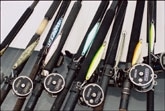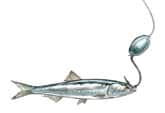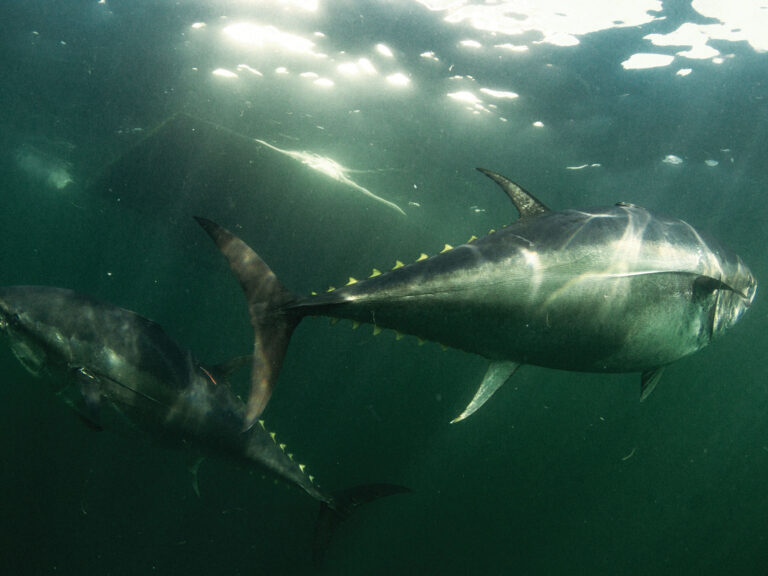
QUESTION: What’s shaped like a tuna, sports racing stripes, fights all out of proportion to its size and, off Southern California, goes by nicknames, such as “bonehead,” “striped tuna,” “Laguna tuna” and “magneto?”
A few years ago, the answer could have been nothing.
|| |—| || |Aggressive feeders, large bonito can be taken on a variety of “hard-iron” jigs.| Well, maybe not quite. While it may have seemed like the once abundant Pacific bonito had become virtually extinct, they were just hanging out in Mexican waters.
You can surely say these popular fish had been conspicuous by their absence when you figure that you had a far greater chance of landing a yellowtail or white seabass off the Southern California coast than you did of boating a bonito. In all of 2002, California anglers caught only 7,520 bonito, and that includes fish taken from private boats, party boats, beaches and piers. By last year, that figure exploded to 441,000 bonito.
So why had the boneheads gone bye-bye? And why have they now returned to these Southern California waters in such large numbers?
FOLLOW THE MONEY
The situation was not that the Pacific bonito was no longer being caught in tonnage numbers, they just weren’t being caught in Southern California waters. To the south, in Mexican waters, commercial fishing boat crews had a different tale to tell.

| |”Boneheads” fall victim to a variety of jig color patterns. | “It was an economic thing,” explained Steve Crooke, senior marine biologist with the California Department of Fish & Game (DFG) Marine Resources Division in Los Alamitos. “The Eastern European countries had discovered Pacific bonito. In places like Croatia and other Slavic countries, fish buyers started paying more for bonito than they pay for yellowfin tuna, and Mexican commercial fishing responded.”
According to the California DFG, from 1988 to 2000, total U.S. Pacific Coast landings (catches) of commercially caught bonito had surpassed those of Mexican commercial landings in only four of those 12 years. And as recently as 1999, a staggering difference was noted: Mexican landings that year totaled 1,730 tons of Pacific bonito, while the U.S. Pacific Coast commercial landings totaled zero.
Mexican purse-seining pressure increased, due to high wholesale market prices. Cool water off Southern California conspired with this economic pressure to keep bonito out of reach of SoCal anglers. Now, thanks to a plummeting market value for bonito, commercial net boats are targeting other species and the striped tuna are again invading from the south, much to the delight of inshore light-tackle anglers and, especially, skippers who operate coastal half- and three-quarter-day party boats.
BATTLING BONITO

| |Anchovies can be fished with or without a sinker. Illustration: Ed Luterio| Many anglers agree that bonito are one of the hardest-fighting fish, pound for pound, in the ocean.
“They’re like skipjack (in fighting ability, for their relative size),” says Crooke. “I guess we’re lucky they don’t grow to 400 pounds.”
Barely considered even a medium-size gamefish, bonito can fully flex a light-action spinning or baitcasting rod and keep it curved for a long time. Go up against it with ultralight-class trout tackle, and a big bonito feels like a German brown trout equipped with afterburners.
One of the toughest bonito tussles I’ve ever experienced occurred at Los Coronados Islands, below San Diego, California, and just a few miles inside Mexican waters. In the middle of a wide-open yellowtail bite, I cast out a large, single-hook, chrome-plated Clyde’s Clobber, let the lure sink a few feet, put the reel in gear and cranked the handle fast. The flashy Clobber zigzagged barely six feet before it got clobbered, and the monofilament started stretching in the opposite direction in a scorching run.
I was certain that I’d hooked the mother of all yellowtail. I chased the fish up one side of the boat and down the other, as 30-pound line streamed off the reel. Finally, several minutes later, the fish was alongside reflecting bright, silvery flashes – not the radiant, amber-glowing tail of a yellow in clear water.
My catch was a relatively large bonito that weighed just under 15 pounds. The lure had somehow wrapped the mono completely around and just aft of the bonito’s head, with the single hook completing its roundtrip by hooking itself on the line. The fish, essentially, was lassoed. It fought so hard because it was able to point its head any direction it wanted as it powered away.
BEST BAITS AND LURES
|| |—| |CARE OF THE CATCH Although Pacific bonito aren’t known for their palate-pleasing flavor, the table quality of the catch can be dramatically improved by following a few easy steps, whether the catch is baked, broiled, battered or barbecued.¿ Always “bleed-out” a freshly caught bonito by making an incision through the fish’s gillrakers in its throat area. After cutting, stand the bonito on its nose in a small, wet burlap bag placed in a plastic chest or bucket.¿ When the blood flow ceases, immediately place the whole fish on ice in a chest.¿ When done fishing, fillet the catch at sea, but be extra careful to leave at least one square inch of the bonito’s skin intact on each fillet (a California regulation) for identification purposes.¿ When filleting, carefully remove the horizontal band of dark, red meat running along each side under the fish’s lateral line.¿ Pack fillets in plastic bags, being careful to keep water out of bags. Also squeeze out excess air before sealing bags.¿ Place bagged fillets on ice in chest the for trip home.¿ Flavor is enhanced even more by preparing and serving refrigerated fillets while still fresh, not frozen.| When encountered in a focused, feeding mode, bonito are relatively easy to catch. Live anchovies are the best natural baits, although small sardines are also effective. Immature mackerel can also appeal, but typically only to the larger bonito. Although bonito can occasionally be hooked on the bottom at depths to 50 or 60 feet, they are much more commonly caught on or within a few feet of the surface, making them vulnerable to fly-lined (no sinker) baits. A light-action, fast-taper, 7 1/2- to eight-foot rod and a palm-size, revolving-spool reel will pitch a ‘chovy out to boat-shy fish hanging in the chumline. On a small boat, light spinning gear and six- or eight-pound-test line is ideal tackle to start out youngsters and to show them how big of a fight a little fish can stage. Indeed, bonito are kid-friendly. Generations of evolving salt water anglers cut their light-tackle teeth on the Pacific bonito. What the species has undeservedly lacked as a table favorite (see sidebar, below) has been more than counterbalanced by what it possesses in fighting spirit. Bonito are often worked into a feeding frenzy that can make almost any angler look talented – producing that every-bait’s-a-bite chaos when the voracious attackers really define “slamming” a bait.
Big bonito will hit leadhead, plastic-tail swimbaits, but many anglers still prefer the more traditional hard-iron lures like those molded in aluminum, or the heavier zinc models made by Salas, Tady, Iron Man and Kicker lures. The largest fish – spanning from seven- or eight-pounders to stocky, ten- to 12-pounders or heavier – have an affinity for lures, as they did on a trip I took in April aboard the three-quarter-day boat San Diego, out of Seaforth Sportfishing in San Diego. While virtually all of the smaller two- to three-pounders making up the majority of the day’s catch were taken on live anchovies, every one of the dozen or so six- to ten-pounders caught fell for a lure. A medium-action, eight- to 8 1/2-foot rod will add length to reach boat-shy, bigger fish, and at least a five-to-one gear ratio, fast-retrieve casting reel will help zip those cast-metal lures through the water. Lure, or “jig” fishermen, as they’re called on the West Coast, most often spool up with 20-, 25- or 30-pound-test mono on their jig reels.
Light-tackle anglers prefer casting reels or light-duty spinning reels spooled with eight- to 12-pound-test lines on 5 1/2-foot rods. Good lure choices are smaller countdown Rapalas, Yo-Zuris or MirrOlures in mackerel or anchovy patterns, or chrome spoons like the Krocodile.
PIER PRESSURE
Pacific bonito, related to the mackerels and tunas, reach a weight of nearly six pounds by the time they are two years old. A nine-pound, nine-ounce fish examined by a DFG biologist was found to be three years old.
Currently, the daily bag limit for bonito is ten fish, only five of which may be less than 24 inches long, measured by fork-length, or weigh less than five pounds.
“What really shows the strength of the bonito comeback is the range in size of the fish,” says Crooke. “That’s a very healthy sign.”
Of the 441,000 sport-caught bonito taken last season, more bonito were caught from piers (294,000) than from private boats and party boats combined (225,000). Some 22,000 were taken from “beaches” (the DFG’s term for breakwalls, jetties, warm-water outflows and intakes). Best fishing sites were widespread.
“The 2004 bonito migration reached northward to the central California coast,” Crooke adds. “Fall was phenomenal off Morro Bay for four- to 12-pounders – there was just tonnage out there.”
| NEW RECORD BONINTO The type of Pacific bonito (Sarda chiliensis) taken by Southern California and Baja anglers is one of three species of the fish – the other two are Sarda orientalis and Sarda australis. The International Game Fish Association recognizes all three species worldwide. The “Southern California” bonito ranges from Alaska to southern Baja California and westward out to the Revillagigedo Islands off Baja’s Pacific Coast. Then, beginning with an overlap in lower Baja waters and ranging southward toward Peru, Sarda orientalis replaces chiliensis. For 27 years, the IGFA all-tackle world record for Pacific bonito stood at 21 pounds, three ounces, set by Brian Picciolo on July 30, 1978. Earlier this year, however, the IGFA approved a new all-tackle mark for the species: a 21-pound, five-ounce Pacific bonito taken on October 19, 2003, by angler Kim Larson. – Chuck Garrison |









